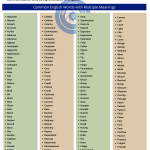Word Order
Word order is one of the fundamental aspects of English grammar. It determines how words are arranged in a sentence to convey the intended meaning clearly and effectively. For English learners, mastering word order is crucial to improving both written and spoken communication skills.
Why Is Word Order Important?
In English, the meaning of a sentence heavily depends on the arrangement of its words. Unlike some languages, English relies less on word endings and more on word position to determine grammatical relationships. For example:
- Correct: The dog chased the cat.
- Incorrect: The cat chased the dog.
Types of Word Order in Sentences
1. Statements (Declarative Sentences)
Standard order: Subject + Verb + Object
Example:
- I enjoy reading books.
- They visited the museum yesterday.
2. Questions (Interrogative Sentences)
Standard order: (Question Word) + Auxiliary Verb + Subject + Main Verb
Example:
- What are you doing?
- Do they like coffee?
3. Commands (Imperative Sentences)
Standard order: Verb + Object (Subject is implied)
Example:
- Close the door.
- Read the instructions carefully.
4. Negative Sentences
Standard order: Subject + Auxiliary Verb + “not” + Main Verb + Object
Example:
- She does not eat meat.
- We are not going to the party.
Common Pitfalls in Word Order
- Adverb Placement
- Incorrect: She drinks often coffee.
- Correct: She often drinks coffee.
- Question Formation
- Incorrect: Where you are going?
- Correct: Where are you going?
- Modifiers Misplacement
- Incorrect: He almost drove his kids to school every day.
- Correct: He drove his kids to school almost every day.
Example Question:
Rearrange the words: “to / we / London / went / last week”
- A) Last week went to London we.
- B) To London we went last week.
- C) We went to London last week.
Answer: C) We went to London last week.
Happy learning! 😊




